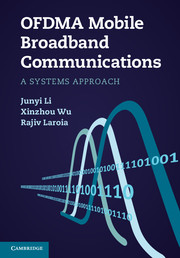Book contents
- Frontmatter
- Dedication
- Contents
- Foreword
- Preface
- List of Notation
- List of Abbreviations
- 1 Introduction
- 2 Elements of OFDMA
- 3 System design principles
- 4 Mitigation and exploitation of multipath fading
- 5 Intra-cell user multiplexing
- 6 Inter-cell interference management
- 7 Use of multiple antennas
- 8 Scheduling
- 9 Handoff in IP-based network architecture
- 10 Beyond conventional cellular frameworks
- A Overview of system operations
- B OFDM point-to-point communications
- C Brief review of channel capacity
- References
- Index
10 - Beyond conventional cellular frameworks
Published online by Cambridge University Press: 05 July 2013
- Frontmatter
- Dedication
- Contents
- Foreword
- Preface
- List of Notation
- List of Abbreviations
- 1 Introduction
- 2 Elements of OFDMA
- 3 System design principles
- 4 Mitigation and exploitation of multipath fading
- 5 Intra-cell user multiplexing
- 6 Inter-cell interference management
- 7 Use of multiple antennas
- 8 Scheduling
- 9 Handoff in IP-based network architecture
- 10 Beyond conventional cellular frameworks
- A Overview of system operations
- B OFDM point-to-point communications
- C Brief review of channel capacity
- References
- Index
Summary
So far we have studied the system design principles of OFDMA-based mobile broadband under a conventional cellular network framework. The basic premises of the framework are:
• The base stations use high transmit power, and are placed at carefully chosen locations, ideally at the vertices of regular hexagons.
• A user is connected to the “best” base station. The best base station is usually the closest one that has the greatest downlink signal strength received at the user.
• A base station is open to all the users within a cell by providing “unrestricted” access service.
• Both the downlink and uplink communications are one-hop between the base station and the users. The users do not communicate directly even if they are nearby to each other.
• The time-frequency resource is reused spatially. Among cells reusing the same resource, a signal transmitted in one cell is treated as interference/noise in another cell.
• The spectrum to be used in a cell is fixed and known to both the base station and the users.
In this chapter, we explore several ideas that go beyond the conventional cellular framework in pursuit of the next performance leap.
The first such idea is heterogenous network topology. Inwireless, moving the transmitter and receiver close to each other increases signal strength, reduces required transmit power and thus interference to other transmissions, and allows dense spectrum reuse.
- Type
- Chapter
- Information
- OFDMA Mobile Broadband CommunicationsA Systems Approach, pp. 365 - 460Publisher: Cambridge University PressPrint publication year: 2013



